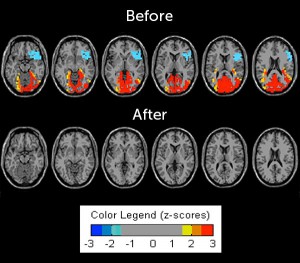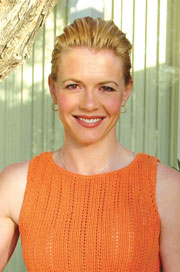Humans are funny. More often than not, it takes a dive in the wrong direction to make us consider doing something to prevent that fall in the first place. Science seems to follow the same bell curve. As problems or statistics start to rise, researchers (who are human by the way) increase their efforts to help find solutions for the rest of us – many for the commercial reward, and others simply for the greater good.
This is what I see happening with brain health. Rates of dementia-related diseases are on the rise, and many of us are struggling as we watch our parents or grandparents cope with these debilitating conditions. And many of us are asking what we can do to help avoid the same fate.

A cap with sensors reads brain activity which translates to progress with the visual and audio computer game.
Fortunately, science is a step ahead of us on this one. Brain enhancing tools have helped those suffering with traumatic brain injury or other dysfunctions for decades, and now these tools are becoming more commonly available to the masses. There are brain games such as Luminosity, Jungle Memory and Cognifit which commercialized the science proving that training in one area could improve the brain in other areas. However, new science is questioning whether these games actually deliver anything more than mere improvement in playing the game itself (“Brain Games Are Bogus,” The New Yorker, April 5, 2013).
The medical wellness community on the other hand is finding much promise in evidence-based neurofeedback (NFB) which has been effectively used as an intervention for ADHD and epilepsy. There is also on-going research of this non-invasive technique for insomnia, anxiety, depression, substance abuse and chronic pain; it is also used to help athletes overcome mental and physical obstacles to their performance.
So just what is it? NFB is defined by the International Society for Neurofeedback & Research as an objective assessment of brain activity and psychological functioning. Assessments include a quantitative EEG which records the brain’s electrical activity at multiple sites on the surface of the scalp (nothing going in – only out), and compares it to a database of normal healthy individuals of the same age as the client. The client completes a questionnaire that addresses common brain related characteristics (quality of sleep, ability to remember names, your happy meter, anxiety levels, etc.) and, with the help of the practitioner, identifies areas the client would like to improve. A training protocol is then developed that specifies sites on the scalp and brain waves to be trained.
The team at the Eisenhower Wellness Institute (EWI) recently began offering neurofeedback, so I thought I would give it a try. As I explained the process to friends and family, they were shocked that I would allow anyone to get into my head. I assured them that nothing was going in, the process was only challenging my brain and measuring what was coming out. I felt confident and in good hands with the EWI team whose technicians are being certified by the NFB governing board, the Biofeedback Certification International Alliance.
It was explained that I would be playing games with my brain which would receive positive reinforcement through specific sights and sounds as my brain activity was “mapped.” How well I did at those games depended largely on “how well-resourced my brain was” which I didn’t really understand until I experienced it firsthand. The 5 resources to consider are: 1) how well you eat (nutrient dense foods/protein, fats, unrefined carbs) and how often; 2) hydration; 3) how well you sleep; 4) physical comfort (as pain takes away from your brain’s ability to focus on tasks); and 5) effective elimination (obviously another brain blocker).
We all know these pillars of health, but with brain training, you actually see the effects firsthand through sights and sounds that represent your brain’s activity. If I ate protein and leafy greens the night before, drank plenty of water and had a good night’s sleep, I would soar through the games. High, bubbly tones would ring in my ears and the “green bar of greatness” would light up in front of me. My brain was celebrating; I was filled with positive emotions – and rewarded with impressive scores.

How well you are ‘resourced’ determines if you are able to successfully pop these water balloons, one of many games from which to choose.
If my pre-training fare was less than perfect, not only could I feel my brain working harder to achieve the same tasks, my onscreen performance would be dismal. The darts my brain was throwing would miss the balloons and land in a teddy bear’s belly, or the butterfly aimed directly at a distant circle would drift off missing its target completely. The green bar wouldn’t budge and an infrequent “bloop” here and there left me feeling as depleted as my brain.
How could this happen? How could I not have total mind control over this silly game I was playing? It only took one bad session for me to become dedicated to “feeding my brain.” I ate all the right things, drank copious amounts of water, and planned for 8 hours of sleep each night. I even went 10 days with no alcohol (a big score tanker at the carnival games). Many things in my life have inspired me to make healthier choices, but nothing like the promise of improved brain function (although I did falter throughout my 10 weeks of training).
So what was I working on improving? Through the questionnaire and meetings with my practitioner, Mary, I identified three things I considered personality flaws which turned out to be all in my head: 1) my obnoxious habit of speaking over others; 2) the inability to recognize faces and remember names; and 3) becoming seriously irritated when interrupted from deep focus and thought. Mary added improved sleep knowing more than I about the beneficial effects of brain training.
I committed to 20 training sessions
(2/week for 9-10 weeks). Each week Mary asked me what I ate, drank, how well I slept, and how I felt I was doing on my goals. I found this to be a little excessive and still feel that a big part of the training is purely conscious awareness, but as the training progressed, I noticed a change – and it wasn’t only me, it was also the people around me. I would quickly pull a name out of a hat and my husband would say, “Whoa! Brain training.” My common response became, “Just call me Smarty Pants.” My irritation at being interrupted – usually directed at those closest to me – was replaced with empathy (I slipped once and was overcome with deep regret and apologies to my mom). The most impressive had to be my behavior in social situations, as I found myself actually listening before I spoke instead of thinking about what I wanted to say next. The ratings on my self-assessment went from 2s and 3s to 8s and 9s.
Was I skeptical? Absolutely. I still don’t fully understand how the process can make such an impactful improvement. Was the success due to the conscious repetition of questions, or did the positive reinforcement of the games really direct my subconscious to “think” differently? Did my brain really become more efficient, or was that due to my enhanced focus on the 5 pillars of health?
Then I saw 20 weeks (and just as many pages) of data on my brain collected, analyzed and summarized. When it was time to review this with the EWI team, the smile on Mary’s face was enough to tell me it must be pretty good. Before pictures showed specific areas of my brain working hard to pull resources; the after pictures showed a much more even distribution of resources and a more efficiently operating mind.

My before and after brain activity in a quiet state with eyes open (placed on stock head images)
Before (top): Colors demonstrate the brain working hard in different states with blue and red representing extremes at both ends of the spectrum.
After (bottom): The complete grey picture indicates function that is near the norm not requiring significant effort.
But that certainly wasn’t how I saw it most clearly. What I experienced was the inability to “amp up” for project mode; I simply eased into it at a steady pace producing the same results. The difference was so significant it actually bothered me. It was explained that while I always thought my uber-productive and focused personality came naturally, it was possible that my brain had to work really hard (reds and blues in the data) to operate in that mode, and that now, it was telling me to trust the ability to produce the same quality at a much more even pace. The good news? The results are reported to last (so I’d better get used to it).
Other Eisenhower Wellness Institute clients have reported similar results: feeling smarter, getting better sleep – even feeling more socially engaged. One older gentleman actually complained that brain training had made him ‘too happy,’ which he was trying to get used to. (The fact that this issue made it on deadline shows that I am getting used to my more efficient self).
I believe we are all part of a smarter generation who is beginning to honor what we put into our body – not only for the brawn, but also for the brain power.
If you are considering brain training, I strongly recommend researching all options and the science behind it, and choosing a program that fits into your lifestyle. Your brain will thank you now, and hopefully for many years down the road.
For more information on neurofeedback, visit the International Society for Neurofeedback & Research at www.isnr.org. The Eisenhower Wellness Institute can be reached
at (760) 610.7360.














































Comments (0)